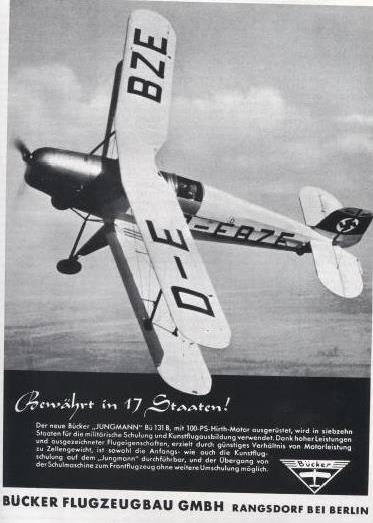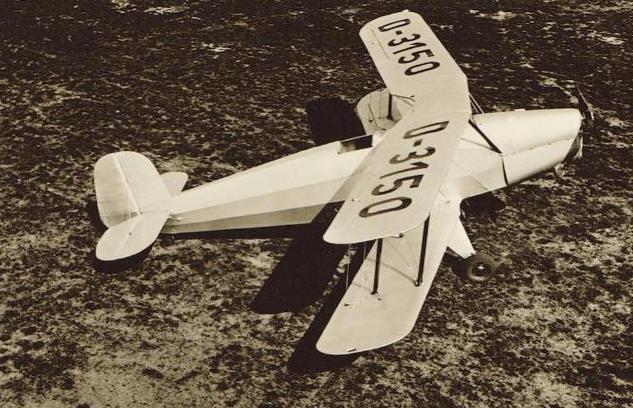| Type |
A Two seat primary trainer |
B Two seat primary trainer |
C Two seat primary trainer |
| Engine |
1 Hirth HM 60R |
1 Hirth HM 504A-2 |
1 Cirrus Minor |
| Dimensions |
Length , height , span , wing area , |
Length 6,62 m , height 2,35 m , span 7,4 m , wing area 13,5 m2 , |
|
| Weights |
Empty , loaded , max. take off weight |
Empty 380 kg, loaded , max. take off weight 670 kg |
|
| Performance |
Max.. speed , cruising speed , range , endurance , service ceiling , climb |
Max.. speed 183 km/h, cruising speed 170 km/h , range 628 km, endurance , service ceiling 4050 m , climb 168 m/min. |
|
Bu 131 A:
Two seat primary trainer.
Bu 131B:
Improved version with a more powerful Hirth HM 504A-2 engine.
Bu 131C:
Experimental version with a Cirrus Minor engine, rated 90 hp.
Bu 131D:
Succeeded the Bu-131B in 1938, with smaller changes and improvements.
Kokusai Ki-86A:
Japanese license for the Japanese air force.
Kyushu K9W1:
Japanese license for the Japanese navy.
Tatra T-l 31:
Czech license version.
Aero C-4:
Czech production version during the war.
Aero C-104:
Czech post war version equipped with a Walter-Minor 4-111 engine.
CASA 1.131:
Spanish license built version.

At that time Germany required high-quality pilot training aircraft as it made concerted efforts to establish a viable new Air Force. The important pioneering work which Bücker and his chief designengineer, the Swede Anders J. Andersson, had done in Sweden resulted in a number of valuable design concepts. As early as March 1934 they were able to present the prototype of a new model to be used as a trainer and also as a sporting aircraft. The plane was constructed within less than four months of the founding of the new company. It was a two-seater biplane which was given the type number "131" by the State Aviation Ministry (Reichsluftfahrtministerium). The maiden flight of this first Bucker aircraft to be built in Germany (Bu 131V-1, registration no. D-3150) took place on 27th April, 1934 in Johannisthal with Joachim von Köppen, a test pilot with the German Aviation Sport Union (DLV), at the controls. After a brief trial period the outstanding flying characteristics and perfornance of this small machine became evident; in spite of its comparetively weak 80 h.p. engine the plane proved to have remarkable mobility and manoeuvrability. With its low fuel consumption, modest price and uncomplicated maintenance requirements, the plane was extremely economical to operate.
The success of the new machine was assured - thanks in large measure to its superb design concept, based on revolutional constructional ideas and a careful balance between engine power and airframe weight. As far as form, styling and execution were concerned, it was both aerodynamically and aesthetically superior to each of its predecessors in this category of biplane. Bücker and Andersson had created the ideal trainer for novice pilots on the one hand and would-be aerobatic pilots on the other. No one suspected then that this would be the last two-seater biplane to be constructed in Germany - or that planes like these would still be flying 50 years on
As a former naval officer and admirer of the Navy, Bücker gave this first aeroplane to be built in his German works the sea- cadet title "Jungmann". Numerous orders for the new type of plane were received even when it was still undergoing trials, and it was decided to start manufacture immediately. Typically, the first machine off the production lines was exported - to Uruguay. By August 1935, fourteen months after the maiden flight of the prototype "Jungmann", no less than 50 of these planes hade been constructed in the small, rented Ambi-Budd hangar. Because of the shortage of space it was impossible to install the wings in this building. Instead, they were transported across the airfield to the flight-test hangar next to the DLV headquarters for final installation to the fuselages, which for their part were moved into position by means of propeller power. Initially, the "Jungmann" (Bu 131 A) was supplied to DLV flying schools with the same engine as the prototype, namely a 4-cylinder Hirth engine HM 60 R rated at 80 h.p.
As for the plane itself, the "Jungmann" was intended as a trainer and was planned and developed accordingly, since it was designed to meet the requirements placed on machine and flying crew in the course of military exercises, it had to be extremely manoeuvrable in order to perform all the aerobatic patterns which such exercises frequently entailed. In addition to the customary aerobatic figures was capable of making nose dives of more than 2,000 metres well as inverted loops; in other words, it could accomplish aerobatics feats generally associated with more powerful aircraft.
The fact that a relatively small, 80 h.p. engine was incorporated in the "Jungmann" meant that the aircraft was approximately
40% less expensive than the standard, higher-powered trainer regards purchace price, fuel consumption, maintenance, etc., with its training capabilities remained practically identical. It is also with mentioning that because of its modest wing span the "Jungman" required less hangar space, with the result that a greater number these planes could be accommodated in one hangar.
The aircraft's performance data - maximum speed 175 km/h per hour; ascent to 1,000 metres in 7 minutes - were entirely adequate for training applications. With its radius of action of 650 km the "Jungmann" could be used for the customary overland flights involved in both primary and secondary training. Although it was apparent to the plane's designers that choice of a monoplane structure for the "Jungmann" would give greater velocity and better climbing attributes, preference was given to the biplane design, which was considered to be very suitable for aerobatic and general training purposes.


